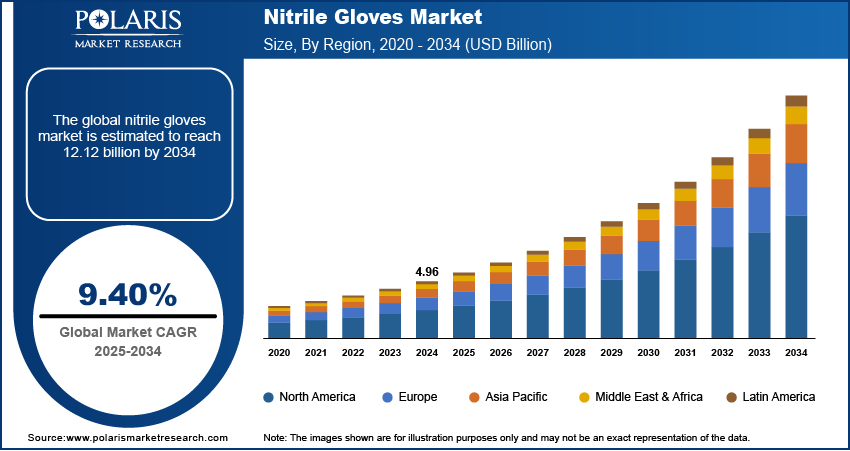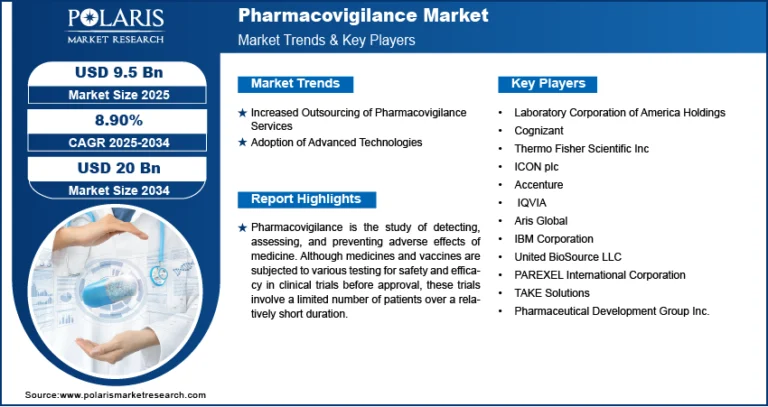Nitrile Gloves Market Projected to Hit USD 12.12 Billion by 2034, Registering a CAGR of 9.40%

The global Nitrile Gloves Market was valued at USD 4.96 billion in 2024 and is expected to grow at a CAGR of 9.40 % from 2025 to 2034.
Key Market Trends & Insights:
- Shift from Latex to Nitrile:
Ongoing allergic reactions associated with natural rubber latex have driven a broad shift toward nitrile gloves, particularly in healthcare and food industries. - Rise in Disposable Glove Consumption:
Single-use nitrile gloves are gaining popularity due to hygiene regulations in industries such as pharmaceuticals, food handling, and janitorial services. - Innovation in Manufacturing & Materials:
Advancements in glove technology, such as thinner yet durable materials and textured surfaces for better grip, are enhancing usability without compromising safety. - Growing Use in Non-Medical Sectors:
Industrial, automotive, and chemical sectors are increasingly adopting nitrile gloves due to their superior chemical resistance and strength. - Focus on Eco-Friendly Production:
Manufacturers are exploring sustainable and biodegradable nitrile alternatives to reduce the environmental footprint of glove waste.
Market Size & Forecast
Market size value in 2025 USD – 5.33 billion
Revenue forecast in 2034 USD – 12.12 billion
CAGR – 9.40% from 2025 – 2034
Request for Free Sample:
https://www.polarismarketresearch.com/industry-analysis/nitrile-gloves-market/request-for-sample
Market Overview:
The nitrile gloves market has emerged as a critical segment within the global personal protective equipment (PPE) industry, experiencing strong demand across healthcare, industrial, food processing, and laboratory sectors. Nitrile gloves, made from synthetic rubber, offer superior chemical resistance, puncture protection, and allergen-free alternatives to latex gloves, making them widely preferred in sensitive environments.
Market Growth Drivers:
- Stringent Regulatory Standards for Workplace Safety:
Government regulations mandating personal protective equipment in sectors like healthcare, chemicals, and food processing continue to drive glove adoption. - Expansion of Healthcare Infrastructure:
Growing investments in healthcare facilities, especially in developing countries, are fueling demand for examination and surgical gloves. - Increased Awareness Post-Pandemic:
The pandemic has left a lasting impact on hygiene consciousness, leading to continued use of protective gloves in everyday and occupational settings. - Growth of E-commerce and Global Supply Chains:
Streamlined procurement through online platforms has expanded access to nitrile gloves across remote and underserved regions. - Rising Incidences of Hospital-Acquired Infections (HAIs):
Preventing HAIs is a critical concern for healthcare providers, promoting the use of disposable nitrile gloves to maintain sterile environments.
Market Challenges:
- Volatile Raw Material Prices:
Fluctuations in the cost of synthetic rubber and other inputs can affect production costs and profit margins. - Environmental Concerns Over Waste:
Nitrile gloves, being non-biodegradable, contribute significantly to medical and industrial waste, prompting scrutiny over their environmental impact. - Supply Chain Disruptions:
Events like pandemics, geopolitical tensions, or export restrictions can disrupt global glove supplies and lead to price spikes. - Quality and Counterfeit Concerns:
The influx of low-quality or counterfeit gloves in the market, especially during supply shortages, poses risks to safety and trust. - Overcapacity and Market Saturation:
Post-pandemic overproduction has led to oversupply in some regions, resulting in pricing pressures and inventory management challenges.






